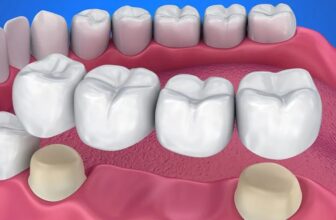
Root canal treatment is often associated with back teeth, but front teeth can also require this procedure. Understanding how root canal treatment works for front teeth can help ease concerns about the process and its importance in maintaining dental health.
If you want to know the average cost of root canal treatment for front teeth in Hubli, it’s essential to consider factors like the complexity of the procedure and the specific dental clinic. Generally, front teeth treatments may differ in cost compared to molars, often due to the varying techniques involved.
What Is a Root Canal Treatment?
Root canal treatment is a dental procedure that removes infected or damaged tissue from inside a tooth. The tooth’s interior contains a soft tissue called pulp, which contains nerves and blood vessels. When the pulp becomes infected or inflamed due to decay, injury, or trauma, it can lead to pain and potential tooth loss. Root canal treatment involves removing this infected pulp, cleaning the root canals, and sealing the tooth to prevent further infection.
Why Do Front Teeth Need Root Canal Treatment?
Front teeth, which include incisors and canines, can experience issues that necessitate root canal treatment. Here are some common reasons:
- Severe Tooth Decay: If decay progresses deep into the tooth, it can reach the pulp, causing infection and pain.
- Trauma or Injury: Accidents or sports injuries can lead to fractures or cracks in the front teeth, exposing the pulp and resulting in infection.
- Recurrent Decay: A previous filling in a front tooth may become compromised, allowing bacteria to enter and infect the pulp.
- Pulpitis: This is the inflammation of the pulp due to various reasons, including untreated cavities or trauma.
Signs That a Front Tooth Needs Treatment
If you suspect a front tooth may need a root canal, look out for the following symptoms:
- Persistent Pain: Ongoing pain in the tooth, especially when biting or applying pressure, is a common sign.
- Sensitivity: Prolonged sensitivity to hot or cold temperatures, even after the source has been removed, can indicate pulp damage.
- Swelling and Tenderness: Swelling in the gums around the affected tooth can suggest an infection.
- Discoloration: A darkening of the tooth can indicate that the pulp is dead or dying.
- Abscess Formation: A pimple-like bump on the gums near the tooth may indicate an abscess caused by infection.
The Root Canal Process for Front Teeth
While the process for root canal treatment is generally the same for front teeth as for back teeth, there are a few differences to note. Here’s a step-by-step overview of what to expect:
1. Diagnosis and Preparation
Your dentist will begin by thoroughly examining the affected tooth, which may include X-rays to assess the extent of the damage or infection. Based on this evaluation, a treatment plan will be formulated.
2. Anesthesia
Local anesthesia will be administered to numb the tooth and surrounding area, ensuring your comfort throughout the procedure.
3. Accessing the Tooth
The dentist will create a small opening in the crown (top) of the tooth to access the pulp chamber and root canals.
4. Removing the Pulp
The dentist will carefully remove the infected or damaged pulp tissue from the canals using specialized instruments.
5. Cleaning and Shaping
Once the pulp is removed, the dentist will clean and shape the canals to prepare them for filling. This step is crucial to eliminate any remaining bacteria and debris.
6. Filling the Canals
The cleaned canals will be filled with a biocompatible gutta-percha material to seal the space and prevent future infections. The access hole will then be sealed with a temporary or permanent filling.
7. Restoration
After the root canal is completed, your dentist may recommend placing a crown or other restoration on the tooth to protect it and restore its function. This is particularly important for front teeth, as they play a key role in your smile.
Recovery and Aftercare
After a root canal treatment, it’s normal to experience some discomfort or sensitivity, which can be managed with over-the-counter pain medications. Here are a few aftercare tips:
- Follow Your Dentist’s Instructions: Adhere to any specific care instructions your dentist provides.
- Avoid Hard Foods: For the first few days, avoid chewing on the treated tooth until it is fully restored.
- Maintain Oral Hygiene: Continue to brush and floss regularly, but be gentle around the treated area.
- Attend Follow-Up Appointments: Return for scheduled follow-up visits to monitor healing and restoration.
Benefits of Root Canal Treatment for Front Teeth
- Preservation of Natural Teeth: Retaining your natural teeth helps maintain your smile and bite.
- Relief from Pain: Addressing the source of infection provides immediate relief from discomfort.
- Preventing Tooth Loss: Timely treatment can prevent the need for extraction and further complications.
- Aesthetic Restoration: With modern dental techniques, front teeth can be restored to look natural and blend seamlessly with the rest of your smile.
Conclusion
Understanding root canal treatment in Hubli for front teeth can help you feel more confident about seeking care if needed. This procedure is essential for saving teeth infected or damaged, ensuring you maintain a healthy, beautiful smile. If you experience any symptoms of infection or damage in your front teeth, don’t hesitate to contact your dentist for an evaluation. Early intervention can make all the difference in preserving your natural teeth and overall dental health.







